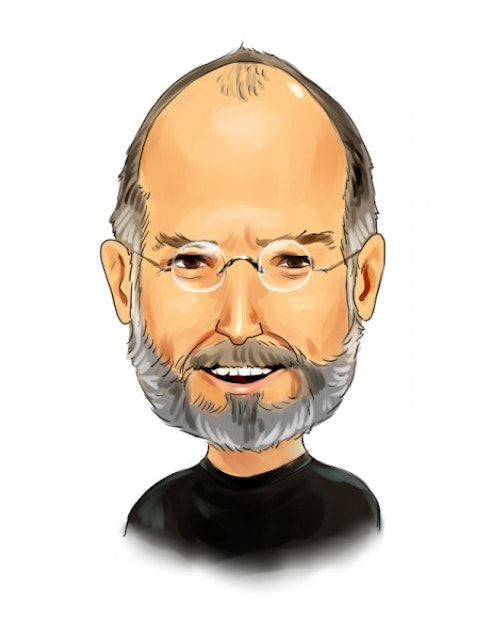Apple Inc (NASDAQ:AAPL) has recently reached the pinnacle of stock market superstardom. On August 20th, it officially became the most valuable stock in history, hitting a market cap of $623.5 billion, topping Microsoft Corporation (NASDAQ:MSFT)‘s tech bubble peak of the late nineties. Even more impressive than this feat is the company’s historical return over the past decade. An investor who purchased $13,000 worth of Apple Inc (NASDAQ:AAPL) stock in 2002 would be a millionaire just ten years later.
Since its IPO debacle in May, Facebook Inc (NASDAQ:FB) has had a decidedly opposite experience, losing close to 50% of its value, currently sporting a market cap just above $40 billion. That’s not to say that the social media company doesn’t have its fair share of bulls, though, as many armchair analysts believe that if Zuckerberg and Co. can “figure out” mobile advertising, it can be eventually reach Apple Inc (NASDAQ:AAPL) territory.
What if we told you that there’s another, less heralded company that has the potential to offer similar appreciation at an otherworldly level over the next decade? For those looking to find what may be the tech industry’s top dog by 2020, look no further than 3D Systems Corporation (NYSE:DDD).
As its name suggests, 3D Systems manufactures three-dimensional printers that can create everything from a guitar to an action figure. Aside from outperforming Apple Inc (NASDAQ:AAPL) and Facebook Inc (NASDAQ:FB) since the start of the year, 3D Systems has been a ridiculously rewarding investment since its shares transferred from the NASDAQ to the NYSE in mid-2011. Since the switch, the stock has returned 89.7%, more than four times that of the software application industry’s average. The best may be yet to come.
Like Apple (NASDAQ:AAPL)’s game-changing entries into the digital music player and smartphone industries, 3D Systems is not the only company operating in the 3D printing space, but it does have the ability to provide consumers with the most usable, streamlined version of the technology. Some of its peers include Stratasys, Inc. (NASDAQ:SSYS), which recently merged with Objet Ltd., and the privately-traded duo of MakerBot and Solidoodle. Hewlett-Packard Company (NYSE:HPQ) also released its first entry into the 3D printing arena in May with the help of Stratasys-patented technology, though the Designjet 3D is only available to European consumers willing to shell out $17,500 for the device.
MakerBot’s newest iteration of the device, called the Replicator 2, costs $2,200, while Stratasys’s flagship Mojo device costs a bit under $10,000. Solidoodle offers a $499 option, though its design is rough, and the company is still relatively new to the game. 3D Systems, meanwhile, has been operating in the 3D printing industry since the technology was invented by its founder Chuck Hull in 1986. 3D Systems offers a bevy of models and its most consumer-friendly option is the Cube 3D, which starts at $1,299.
Drawing on the Apple Inc (NASDAQ:AAPL) comparison once more, 3D Systems looks to offer consumers the best combination of functionality and usability, as its printer requires no assembly, and operates with a simplistic “coloring book” design interface. While artists may prefer professional-grade options from MakerBot or HP, it is a safe bet that the majority of users will prefer the office-friendly feel of the Cube 3D over its peers, and parents will undoubtedly want their kids to play with something that doesn’t look like it was assembled in a high-school shop class. Here’s a neat video comparison of both devices — you be the judge.
Aside from the aesthetics, 3D Systems has pre-made apps that look eerily similar to early versions of Apple Inc (NASDAQ:AAPL)’s App Store, and offers its most creative Cube 3D users to draw their own designs with free software. Now, before you claim: “oh it looks like 3D Systems is geared toward the casual consumer while its competitors are geared toward the hardcore artist,” it’s also important to remember that the company also offers the higher-grade ProJet and ZPrinter series, while its BotMill also offers plenty of customization. For its entrepreneurial users, 3D Systems also offers an outlet to sell designs online.
To put it simply, 3D Systems’s role in its industry is equivalent to a hypothetical scenario where Apple Inc (NASDAQ:AAPL) offered its current stable of iPods, and serious competitors only had a 160 gig version to sell. There are obvious advantages to giving consumers more price points, and being the actual creator of the 3D printing industry, 3D Systems has additional clout.
While the stock has generated a great return throughout its history, there’s still reason to believe that 3D Systems can be a ten-bagger by the end of this decade. At its current price in the $37 range, 3D Systems actually trades at a modest forward earnings multiple of 24.7X and a TTM P/E of 64.1X. By comparison, Apple Inc (NASDAQ:AAPL) sported an P/E above 100 for the better part of the early 2000s, while Hewlett-Packard and Microsoft were even more expensive at the height of the tech bubble.
Though it arguably has a less-promising game plan at the moment, Facebook Inc (NASDAQ:FB) also currently trades at a much higher forward multiple (108.4X) that 3D Systems. Seriously, are the markets really valuing a social media network that will never create a tangible product, at a level that is four times higher than a company that makes its living from giving consumers the power to create?
While there’s always the argument of industry-specific premiums, social media is still a relatively young field in the world of publicly-traded stocks, and it’s possible that the scales of valuation can level over the long run. With a technology is as important as 3D printing, it’s unfair to compare 3D Systems with its 2D brethren, HP included. In comparison to its only other U.S.-listed direct competitor Stratasys, 3D Systems trades at a 10% trailing P/E discount, and a near-30% discount when using forward-looking estimates.
Similar to one of Apple Inc (NASDAQ:AAPL)’s main advantages in its industry, 3D Systems operates a very tight ship, currently generating gross margins close to 50%, while displaying consistent EPS growth. The company reported earnings that were in-line with estimates last quarter, and currently expects to finish 2012 with an EPS of $1.02, more than 30% higher than the level it reached last year. Over a longer term, 3D Systems is expected to grow its bottom line at an annual rate of 19.6% over the next half-decade, more than a full percentage point above Stratasys. When this growth is factored into its valuation, we can see that 3D Systems sports a modest PEG ratio of 1.6, above Apple (0.4) and Facebook (1.2), but below Stratasys (3.7) and HP (2.0).
While rumors of an Apple Inc (NASDAQ:AAPL) buyout are interesting, investors can feel comfortable jumping into 3D Systems even if it continues its current course. The company recently acquired scan-software company Rapidform, and expects the move to add an additional 6-9 cents to next year’s earnings.
In the hedge fund industry, big-name fund managers that are buying into 3D Systems include: Cliff Asness, Richard Driehaus, D.E. Shaw, and Louis Navellier. Here’s a complete list of the managers that are bullish on the company, and while it’s not as extensive as those who hold a stock like Apple Inc (NASDAQ:AAPL) or Facebook Inc (NASDAQ:FB), it may just mean that astute investors currently have a chance to beat the “big money” into 3D Systems. With an attractive valuation, strong history of performance, and dominant position in the 3D printing industry, this stock looks like a superb play at the moment.
Disclosure: none






